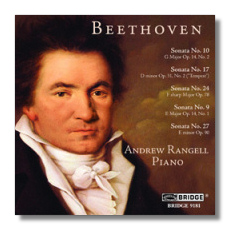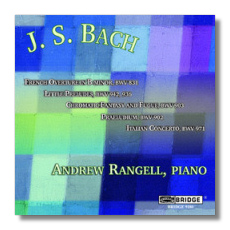
The Internet's Premier Classical Music Source
Related Links
- Latest Reviews
- More Reviews
-
By Composer
-
Collections
DVD & Blu-ray
Books
Concert Reviews
Articles/Interviews
Software
Audio
Search Amazon
Recommended Links
Site News
 CD Review
CD Review
Rangell Plays Bach & Beethoven

Ludwig van Beethoven
- Piano Sonata #9 in E Major, Op. 14 #1
- Piano Sonata #10 in G Major, Op. 14 #2
- Piano Sonata #17 in D minor, Op. 31 #2 "Tempest"
- Piano Sonata #24 in F Sharp Major, Op. 78
- Piano Sonata #27 in E minor, Op. 90
Andrew Rangell, piano
Bridge 9181 DDD 79:25


Johann Sebastian Bach
- Chromatic Fantasy and Fugue, BWV 903
- French Overture in B minor, BWV 831
- Italian Concerto, BWV 971
- Little Prelude in A minor, BWV 942
- Little Prelude in D Major, BWV 936
- Praeludium in G Major, BWV 902
Andrew Rangell, piano
Bridge 9180 DDD 61:11
Rangell's Beethoven disc is anything but dull. Each sonata is given a character of its own, and to hear Rangell play this collection of five disparate sonatas is to be given insight not just into the contradictory personality of the composer, but of the pianist himself. I've heard most of Rangell's CDs, and it is this one which most makes me suspect that he channeling the spirit of late Canadian pianist Glenn Gould… not so much for his detaché playing as for his ability to completely rethink how this repertoire is supposed to sound.
I'd be interested to know from which edition Rangell is playing. The pianist makes many idiosyncratic changes to what is on the printed page, at least as I know it. (He takes all the repeats, however.) These include changes in dynamics (most frequently), the addition of ornaments, the rolling of chords, and – in a few instances – an added or even a changed note. Admittedly, many of these may simply be a part of Rangell's interpretation; musicians have always exercised the option of ignoring or modifying the score. Rangell also takes an extremely elastic approach to tempo and rhythm. This can be heard almost immediately at the start of the G-major sonata; Rangell inserts little micro-pauses, if you will, in and between phrases. These really make the listener catch his breath and wonder what is going on. Over time, Rangell's push-and-pull phrasing may seem more an affectation than a revelation, but for now at least, I am willing to go along with it. His willingness to upset the apple cart seems quite typical of the composer himself. This is not sensationalism, though. There's an excellent intelligence at work here, and a fine sense of humor, and both the humor and the intelligence are attached to a set of fingers that can realize any idea, no matter how technically difficult it might be. The pianist's avoidance of the sustaining pedal gives him precious little space in which to hide. Rangell has all 32 Beethoven sonatas in his repertoire. Wouldn't it be nice if Bridge gave him the opportunity to record all of them?
Gould's spirit inhabits the Bach CD as well. (Fortunately, Rangell seems able to do without Gould's vocals and squeaky stool!) Another inspiration might have been the Brazilian pianist João Carlos Martins. Rangell avoids the latter's tendency to cram as many notes as possible into the space of a second, and he leavens his detaché playing with legato where appropriate, but in general, all three pianists play Bach with a challenging degree of subjectivity, and with little concern for remaining within what is understood today as authentic Baroque style. For example, the French Overture begins as if it were emerging from an early-morning fog, with a kind of lazy intimacy that contradicts the almost regal approach favored by most keyboard players. Again, Rangell treats rhythms with flexibility. One might call it rubato, except in true rubato playing, the pianist is supposed to return whatever he "steals," whereas Rangell does not seem particularly concerned about this. Rangell takes the "fantasy" aspects of BWV 903 quite literally: Bach's phrases are expanded and contracted, and the overall effect is nothing if not fantastic, in the most literal sense of the word. Later, the Fugue steals in like a cat-burglar. Even more than on the Beethoven CD, we can hear Rangell's technical excellence in his ability to keep Bach's polyphonic lines balanced and independent, and to give them their own timbres too. I predict that the Bach CD will be even more controversial than the Beethoven. The playing is mannered and often calls attention to itself, and yet Rangell's ideas are so interesting that we are fascinated rather than repelled.
On both discs, Rangell plays the Hamburg Steinway model D; the recording location is the Gardner Museum in Boston. The sound is a little hard and dry – good for Beethoven and Bach, but not so good for Chopin, for example. The booklets include the pianist's own annotations, which are as personal and intelligent as his playing.
Copyright © 2006, Raymond Tuttle




















